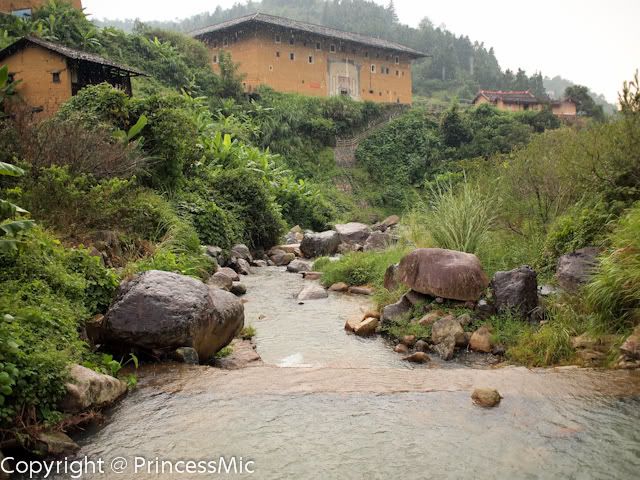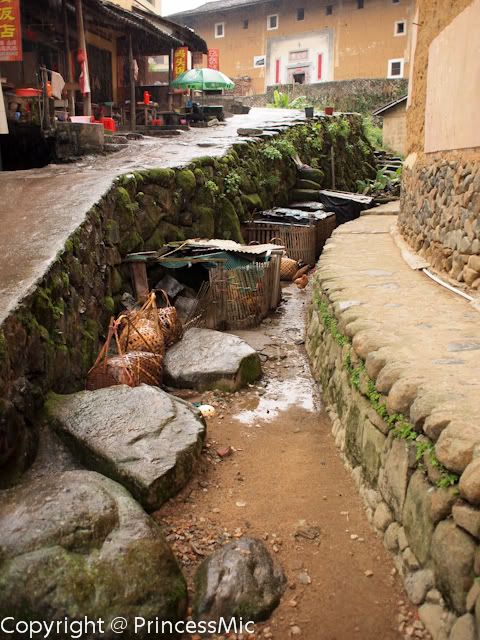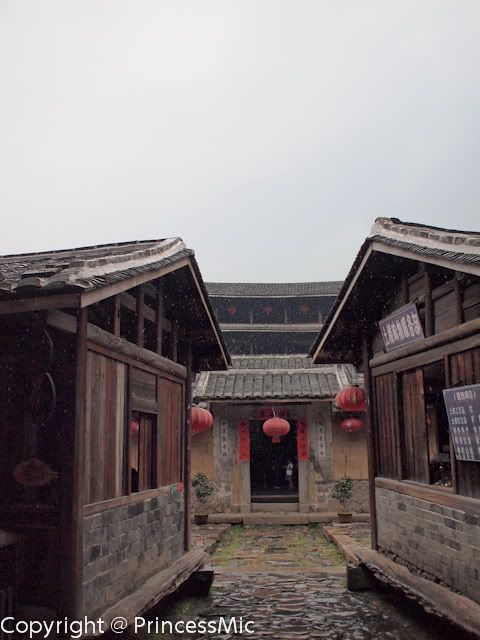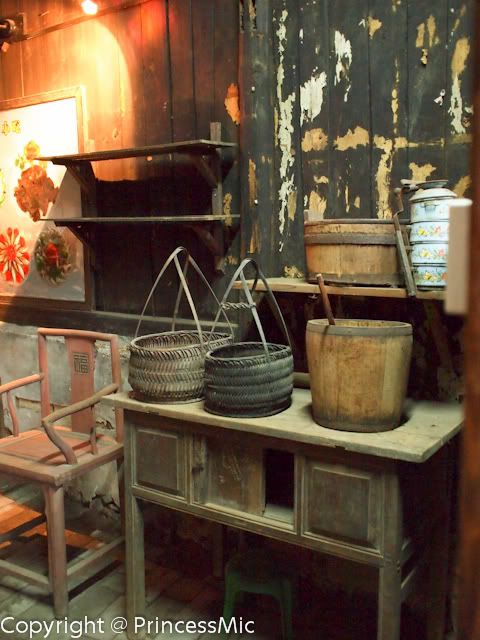i wrote this post with a heavy heart and you probably will feel the same way too once u finish reading this post. This is a very short trip for me but i do learn a lot from this trip which also includes some of my regrets that is bugging me since day 1.
not many people know that i am born in a family of a hokkien + hakka family ~ my dad is a hakka and my mum is a hokkien. since young , i am brought up in a chinese speaking family plus a little bit of teo chew. also due that my late parental grandma aka ah poh ( my late parental grandpa passed away many years ago when my dad was 13 yrs old) is closer to my auntie's children, so i am one hakka than cannot understand or even speak a single word of hakka. frankly speaking, i am not proud to be a hakka but this is something that cannot hide as my surname confirms i am a hakka to many people.
since i dont live with ah poh all the while, so there are many living habits that she has and i cant align with. she usually come back to stay with me during chinese new year and this is the period i used to dread most and now this is the period i miss most. the reason why i dread most is cause my house is very small and i always need to give up my bed to her and she had alot of funny habits like she wants the whole room to be lights out when she sleeps, she doesnt take chicken and fried food, she like to sleep super early and wake up super early..etc.her living habits was totally opposite of mine which i find so difficult and frustrated whenever she is here. it all happen until she fall very sick and passed away last year. i begin to miss her.
only then i realize that for the past 30 yrs she is with me, never in my life i appreciate her and try to even understand her more. then, i got this chance to visit her hometown, also my grandpa hometown ~ Xiamen (Yong Ding) with Fur in this trip i called finding our roots. Surprisingly our ancestors came from the same hometown. i hoped that during this trip i can actually learn more about my roots and find out more about my grandparents. so probably you will wonder what is hakka?
below taken from http://en.wikipedia.org/wiki/Hakka_people
Hakka 客家 Hak-kâ 客家漢族[1]
Total population estimated 80 million worldwide Regions with significant populations Greater China (Guangdong, Fujian, Jiangxi, Guangxi, Hong Kong, Taiwan), Southeast Asia (Malaysia, Indonesia, Philippines, Thailand, Singapore) Languages Hakka + language(s) of their country of residence Religion Predominantly Mahayana Buddhism, Confucianism, Taoism, Traditional Chinese religion. Minority Christianity Related ethnic groups Other Han Chinese Hakka people Chinese 客家 [show]Transcriptions first alternative Chinese name Chinese 客人 [show]Transcriptions The Hakka (Hakka: Hak-kâ; Chinese: 客家; pinyin: Kèjiā), sometimes Hakka Han,[1][2] are Han Chinese who speak the Hakka language and have links to the provincial areas of Guangdong, Jiangxi, Guangxi, Sichuan, Hunan and Fujian in China. The characters 客家 come from words indicating "visitors" or "travellers" and distinguish the Hakka from the Tujia ("natives"). The Hakka's ancestors were often said to have arrived from what is today's central China centuries ago.[3] In a series of migrations, the Hakkas moved, settled in their present locations in southern China, and then often migrated overseas to various countries throughout the world.[4] The worldwide population of Hakkas is about 80 million, though the number of Hakka-language speakers is fewer.[5] Hakka people have had a significant influence on the course of Chinese and world history: in particular, they have been a source of many revolutionary, government, and military leaders.
Origins, migrations and group identification
It is commonly held that the Hakka are a subgroup of the Han Chinese originating from northern China.[6] The ancestors of the Hakka invaded southwards several times because of social unrest, upheaval, and continued invasion by foreign forces since the Jin Dynasty (265–420). Subsequent migrations occurred at the end of the Tang Dynasty in the 10th century and during the end of the Northern Song Dynasty in 1125, which saw a massive flood of refugees fleeing southward when the Jurchens captured the northern Song capital of Bianliang. A further southward migration may have continued[original research?], as the Mongols defeated the Jurchen Jin Dynasty and proceeded to take down the Southern Song, establishing the Yuan Dynasty in 1271. The precise movements of the Hakka people remain unclear during the period when the Ming Dynasty overthrew the Yuan in the 14th century and subsequently fell to the Manchus who formed the Qing Dynasty in 17th century. Hakka have suffered persecution and discrimination ever since they started migrating to southern parts of China. During the reign of Qing Emperor Kangxi (1654–1722), the coastal regions were evacuated by imperial edict for almost a decade, due to the dangers posed by the remnants of the Ming court who had fled to the island of Taiwan. When the threat was eliminated, the Kangxi Emperor issued an edict to re-populate the coastal regions. To aid the move, each family was given monetary incentives to begin their new lives; newcomers were registered as "Guest Families" (客戶, kèhù). Due to their agrarian lifestyle, the Hakkas have a unique architecture based on defense and communal living (see Hakka architecture), and a hearty savory cuisine based on an equal balance between texturised meat and vegetables, and fresh vegetables (see Hakka cuisine). When Hakkas expanded into areas with pre-existing populations, there was often little agricultural land left for them to farm. As a result, many Hakka men turned towards careers in the military or in public service. Consequently, the Hakka culturally emphasized education. Hakka people built the Tulou buildings, which UNESCO inscribed in 2008 as a World Heritage Site.[9] Historically, Hakka women did not bind their feet when the practice was commonplace in China.
well, this trip i got to visit one of the tulou. actually many people have the misconcept that tulou is always round but in actual fact, the first version of tu lou is in form of rectangle and slowly they change it to round. its amazing that everyone live under the same roof and in the tulou, you also get facilities too like blacksmith, cinemas,..almost like our modern days condominium. lolx.i also come to understand why my grandpa opens a steel factory cos hakka specialize in making weapons to protect their village.
what is a tulou?
Fujian Tulou (Chinese: 福建土楼; pinyin: Fújiàn Tǔlóu, "Fujian earthen structures") is a type of Chinese rural dwellings[1] of the Hakka and others in the mountainous areas in southeastern Fujian, China. They were mostly built between the 12th and the 20th centuries.[2]
A tulou is usually a large, enclosed and fortified earth building, rectangular or circular in configuration, with very thick load-bearing rammed earth walls between three and five storeys high and housing up to 80 families. Smaller interior buildings are often enclosed by these huge peripheral walls which can contain halls, storehouses, wells and living areas, the whole structure resembling a small fortified city.[3]
The fortified outer structures are formed by compacting earth, mixed with stone, bamboo, wood and other readily available materials, to form walls up to 6 feet (1.8 m) thick. Branches, strips of wood and bamboo chips are often laid in the wall as additional reinforcement. The end result is a well-lit, well-ventilated, windproof and earthquake-proof building that is warm in winter and cool in summer.[3] Tulous usually have only one main gate, guarded by 4–5-inch-thick (100–130 mm) wooden doors reinforced with an outer shell of iron plate. The top level of these earth buildings has gun holes for defensive purposes.
A total of 46 Fujian Tulou sites, including Chuxi tulou cluster, Tianluokeng tulou cluster, Hekeng tulou cluster, Gaobei tulou cluster, Dadi tulou cluster, Hongkeng tulou cluster, Yangxian lou, Huiyuan lou, Zhengfu lou and Hegui lou, have been inscribed in 2008 by UNESCO as World Heritage Site, as "exceptional examples of a building tradition and function exemplifying a particular type of communal living and defensive organization [in a] harmonious relationship with their environment".[2]
Chengqilou 承啟樓 nicknamed "the king of tulou", of Gaobei Tulou cluster 高北土樓群
at Gaotou village of Yongding County was built in 1709. Inscribed as
UNESCO World Heritage Site 1113-003 in 2008. It is massive rotunda tulou
with four concentric rings surrounding an ancestral hall at the center,
the outer ring is 62.6 metres in diameter and four storeys tall, 288
rooms, with 72 rooms on each level, circular corridor on 2nd to 4th
floor, with four sets of staircases at cardinal points connecting ground
to top floors. A big roof extending out ward covers the main ring. The
ground floor rooms are kitchens for family branches, the second level
rooms are grain storage rooms, and the 3rd and 4th floor rooms are
living quarters and bedrooms. The second ring of 80 rooms is two storeys
high, with 40 rooms on each level, the third ring served as community
library, one storey with 32 rooms; there are 370 rooms in all. The 4th
ring is a circular covered corridor surrounding the ancestral hall. If a
person stayed for one night in each room, it would take him more than a
year to go through all the rooms.[5]
The ancestral hall is at the centre. Chengqilou has two main gates and
two side gates. 15th generation Jiang clan with 57 families and 300
people live here. At its heyday, there were more than 80 family branches
lived in Chengqilou.
Other buildings in this cluster include: a three ring Shenyuanlou, outer ring 70m diameter; a Wujiaolou (pentagon) with irregular pentagonal floor plan and a rectangular tulou, the Shi-Ze lou
more information -> http://en.wikipedia.org/wiki/Fujian_Tulou
the trip to tulou gives me alot of mixed feelings. especially this is a place where my grandparents born and grow up, get married before they move to Singapore to settle down. well, so much for today, will continue more about my trip ...stay tuned..
not many people know that i am born in a family of a hokkien + hakka family ~ my dad is a hakka and my mum is a hokkien. since young , i am brought up in a chinese speaking family plus a little bit of teo chew. also due that my late parental grandma aka ah poh ( my late parental grandpa passed away many years ago when my dad was 13 yrs old) is closer to my auntie's children, so i am one hakka than cannot understand or even speak a single word of hakka. frankly speaking, i am not proud to be a hakka but this is something that cannot hide as my surname confirms i am a hakka to many people.
since i dont live with ah poh all the while, so there are many living habits that she has and i cant align with. she usually come back to stay with me during chinese new year and this is the period i used to dread most and now this is the period i miss most. the reason why i dread most is cause my house is very small and i always need to give up my bed to her and she had alot of funny habits like she wants the whole room to be lights out when she sleeps, she doesnt take chicken and fried food, she like to sleep super early and wake up super early..etc.her living habits was totally opposite of mine which i find so difficult and frustrated whenever she is here. it all happen until she fall very sick and passed away last year. i begin to miss her.
only then i realize that for the past 30 yrs she is with me, never in my life i appreciate her and try to even understand her more. then, i got this chance to visit her hometown, also my grandpa hometown ~ Xiamen (Yong Ding) with Fur in this trip i called finding our roots. Surprisingly our ancestors came from the same hometown. i hoped that during this trip i can actually learn more about my roots and find out more about my grandparents. so probably you will wonder what is hakka?
below taken from http://en.wikipedia.org/wiki/Hakka_people
Hakka 客家 Hak-kâ 客家漢族[1]
Total population estimated 80 million worldwide Regions with significant populations Greater China (Guangdong, Fujian, Jiangxi, Guangxi, Hong Kong, Taiwan), Southeast Asia (Malaysia, Indonesia, Philippines, Thailand, Singapore) Languages Hakka + language(s) of their country of residence Religion Predominantly Mahayana Buddhism, Confucianism, Taoism, Traditional Chinese religion. Minority Christianity Related ethnic groups Other Han Chinese Hakka people Chinese 客家 [show]Transcriptions first alternative Chinese name Chinese 客人 [show]Transcriptions The Hakka (Hakka: Hak-kâ; Chinese: 客家; pinyin: Kèjiā), sometimes Hakka Han,[1][2] are Han Chinese who speak the Hakka language and have links to the provincial areas of Guangdong, Jiangxi, Guangxi, Sichuan, Hunan and Fujian in China. The characters 客家 come from words indicating "visitors" or "travellers" and distinguish the Hakka from the Tujia ("natives"). The Hakka's ancestors were often said to have arrived from what is today's central China centuries ago.[3] In a series of migrations, the Hakkas moved, settled in their present locations in southern China, and then often migrated overseas to various countries throughout the world.[4] The worldwide population of Hakkas is about 80 million, though the number of Hakka-language speakers is fewer.[5] Hakka people have had a significant influence on the course of Chinese and world history: in particular, they have been a source of many revolutionary, government, and military leaders.
Origins, migrations and group identification
It is commonly held that the Hakka are a subgroup of the Han Chinese originating from northern China.[6] The ancestors of the Hakka invaded southwards several times because of social unrest, upheaval, and continued invasion by foreign forces since the Jin Dynasty (265–420). Subsequent migrations occurred at the end of the Tang Dynasty in the 10th century and during the end of the Northern Song Dynasty in 1125, which saw a massive flood of refugees fleeing southward when the Jurchens captured the northern Song capital of Bianliang. A further southward migration may have continued[original research?], as the Mongols defeated the Jurchen Jin Dynasty and proceeded to take down the Southern Song, establishing the Yuan Dynasty in 1271. The precise movements of the Hakka people remain unclear during the period when the Ming Dynasty overthrew the Yuan in the 14th century and subsequently fell to the Manchus who formed the Qing Dynasty in 17th century. Hakka have suffered persecution and discrimination ever since they started migrating to southern parts of China. During the reign of Qing Emperor Kangxi (1654–1722), the coastal regions were evacuated by imperial edict for almost a decade, due to the dangers posed by the remnants of the Ming court who had fled to the island of Taiwan. When the threat was eliminated, the Kangxi Emperor issued an edict to re-populate the coastal regions. To aid the move, each family was given monetary incentives to begin their new lives; newcomers were registered as "Guest Families" (客戶, kèhù). Due to their agrarian lifestyle, the Hakkas have a unique architecture based on defense and communal living (see Hakka architecture), and a hearty savory cuisine based on an equal balance between texturised meat and vegetables, and fresh vegetables (see Hakka cuisine). When Hakkas expanded into areas with pre-existing populations, there was often little agricultural land left for them to farm. As a result, many Hakka men turned towards careers in the military or in public service. Consequently, the Hakka culturally emphasized education. Hakka people built the Tulou buildings, which UNESCO inscribed in 2008 as a World Heritage Site.[9] Historically, Hakka women did not bind their feet when the practice was commonplace in China.
well, this trip i got to visit one of the tulou. actually many people have the misconcept that tulou is always round but in actual fact, the first version of tu lou is in form of rectangle and slowly they change it to round. its amazing that everyone live under the same roof and in the tulou, you also get facilities too like blacksmith, cinemas,..almost like our modern days condominium. lolx.i also come to understand why my grandpa opens a steel factory cos hakka specialize in making weapons to protect their village.
what is a tulou?
Fujian Tulou (Chinese: 福建土楼; pinyin: Fújiàn Tǔlóu, "Fujian earthen structures") is a type of Chinese rural dwellings[1] of the Hakka and others in the mountainous areas in southeastern Fujian, China. They were mostly built between the 12th and the 20th centuries.[2]
A tulou is usually a large, enclosed and fortified earth building, rectangular or circular in configuration, with very thick load-bearing rammed earth walls between three and five storeys high and housing up to 80 families. Smaller interior buildings are often enclosed by these huge peripheral walls which can contain halls, storehouses, wells and living areas, the whole structure resembling a small fortified city.[3]
The fortified outer structures are formed by compacting earth, mixed with stone, bamboo, wood and other readily available materials, to form walls up to 6 feet (1.8 m) thick. Branches, strips of wood and bamboo chips are often laid in the wall as additional reinforcement. The end result is a well-lit, well-ventilated, windproof and earthquake-proof building that is warm in winter and cool in summer.[3] Tulous usually have only one main gate, guarded by 4–5-inch-thick (100–130 mm) wooden doors reinforced with an outer shell of iron plate. The top level of these earth buildings has gun holes for defensive purposes.
A total of 46 Fujian Tulou sites, including Chuxi tulou cluster, Tianluokeng tulou cluster, Hekeng tulou cluster, Gaobei tulou cluster, Dadi tulou cluster, Hongkeng tulou cluster, Yangxian lou, Huiyuan lou, Zhengfu lou and Hegui lou, have been inscribed in 2008 by UNESCO as World Heritage Site, as "exceptional examples of a building tradition and function exemplifying a particular type of communal living and defensive organization [in a] harmonious relationship with their environment".[2]
can you imagine my grandparents lived in such kind of houses when they where young?
some pictures taken inside the tulou
some of the facilities in the tulou
some of the other exhibits they have.
the tu lou we visited actually exist 500 years ago, it has gone tru many many centuries and have a very strong historical background. now, it no longer house people but as a open house for tourists to visit. there are 4 storeys in each tulou. first level is the kitchen and other facilities. second level is the storage area and 3rd and 4 level is bedrooms. below is the picture of the window looking out. i can imagine when my grandparents looking out of the window from their bedroom...
information about the tulou we visited
Other buildings in this cluster include: a three ring Shenyuanlou, outer ring 70m diameter; a Wujiaolou (pentagon) with irregular pentagonal floor plan and a rectangular tulou, the Shi-Ze lou
more information -> http://en.wikipedia.org/wiki/Fujian_Tulou
the trip to tulou gives me alot of mixed feelings. especially this is a place where my grandparents born and grow up, get married before they move to Singapore to settle down. well, so much for today, will continue more about my trip ...stay tuned..


















Too bad my parents dunno where my grandparents is from...maybe we got the same ancestors too XD
ReplyDeletereally? u r a hakka too? whats your surname? mayb we same family tree too lolx
ReplyDelete